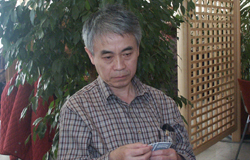| 36th World Team Championships, Monte Carlo, Monaco | Thursday, 6 November 2003 |
Japan v Australia – Senior Bowl Round 5 After two days play the Australian Senior team was lying third, just 2 VPs behind the leaders. Round Five saw them face Japan, also well in touch in seventh position.
Bill Haughie preferred to play on hearts when North showed out on the second diamond and tried leading to the ten at trick two. Kyoko Ohno took the ©K and returned the nine to dummy’s queen. Haughie played dummy’s club and Akihiko Yamada split his honours. Haughie won the §A and cashed the spades then led to the heart ace. Down to three clubs and a losing heart, he exited with a low club and Yamada had to win the nine. He could cash a spade but had kept too many clubs so now had to concede the last trick to declarer’s jack; nine tricks for +400 but 1 IMP to Japan.
Lorentz showed a weak no trump while Yamada’s sequence promised 15-17, making the subsequent decisions automatic. After a heart lead and spade switch, Lorentz took both heart and club finesses to come to eleven tricks for +210. Ohno received a spade lead to the ten and king. She ran the jack of hearts to the king and back came the ªJ for queen, ducked. A heart to the nine won and now Ohno gave up a spade. She did not take the club finesse so held herself to ten tricks for +430 and 6 IMPs to Japan.
How should you handle the West cards after South’s take-out double? The two Wests were actually in quite different situations because Haughie had virtually guaranteed four clubs while Naniwada might have had only two. Alan Walsh jumped to 4§ and Haughie raised himself to game, leaving Ohno with no option but to bid 5¨. With his right-hand-opponent having been forced to bid under pressure, Walsh could not justify bidding again, despite his extra distribution. He led the jack of hearts but there was nothing to the hand; +600. Tadayoshi Nakatani could not afford to jump quite so aggressively
at his first turn and contented himself with a raise to 3§, however,
that worked very well a sit allowed him to show the spades at his
next turn and now it was an easy matter for Naniwada to go on to
5ª over 5¨. Five Spades doubled was down only one for –100
but 11 IMPs to Japan.
Ohno contented herself with a simple raise of the 1ª response, downgrading the singleton ace slightly. East/West do very well in a diamond contract, but the vulnerability dissuaded Haughie from protecting. He passed out 2ª and led a club. Yamada won dummy’s ace and played the ªQ to the bare king and back came a second club. Yamada won and played another spade. Haughie won the ace and switched to a heart so the defence got its heart tricks and a club ruff; just made for +110. Lorentz could show an invitational spade raise with a singleton diamond so did so – a slight stretch, perhaps, but the ability to describe the distribution perhaps justifies that. John Lester went on to game and this time the lead was a low trump followed by a club switch. The defence was a tempo behind now so the club ruff was lost, but there were still four major-suit losers; down one for –50 and 4 IMPs to Japan.
Both Norths opened with a weak no trump but the respective Easts chose very different approaches to showing their potentially very powerful hand. Naniwada made a simple overcall in spades while Haughie preferred to show any strong two-suite. The first approach found an easy raise to game from Nakatani while Walsh had to find a sensible response in an undiscussed sequence. His 4© bid was intended and taken as pass or correct so 4ª was again the final contract. Ohno led a spade while Lorentz chose a club, so +710 for Haughie and +680 for Naniwada; 1 IMP to Australia.
There is one slim chance for declarer in 4ª, given that the clubs are both offside, namely that the ¨9 will become established for a club discard. Both Souths led the ace and king of diamonds then switched to the five of clubs for the jack and queen. Lester duly cashed the ace of clubs now for down one; -100. Yamada tried to cash the ¨Q instead and that was ten tricks for +620 and 12 IMPs to Australia. Haughie followed with the §4, so with Ohno’s switch being systemically third or fifth, there should have been no possibility of confusion, unless I misread the Japanese convention card. Despite this mishap, Japan led 25-18 at half-time. The second half saw Australia come through to win by 48-33IMPs, 18-12VPs. |
||||||||||||||||||||||||||||||||||||||||||||||||||||||||||||||||||||||||||||||||||||||||||||||||||||||||||||||||||||||||||||||||||||||||||||||||||||||||||||||||||||||||||||||||||||||||||||||||||||||||||||||||||||||||||||||||||||||||||||||||||||||||||||||||||||||||||||||||||||||||||||||||||||||||||||
| Page 3 |

